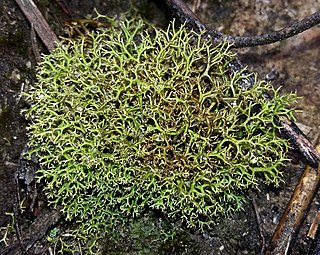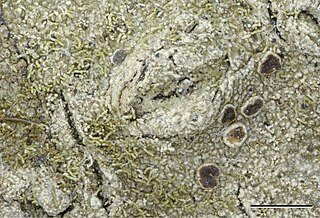
The Graphidaceae are a family of lichen-forming fungi in the order Graphidales. The family contains nearly a hundred genera and more than 2000 species. Although the family has a cosmopolitan distribution, most Graphidaceae species occur in tropical regions, and typically grow on bark.

Cladia is a genus of lichenized fungi in the family Cladoniaceae. Cladia species have a crustose primary thallus and a fruticose, secondary thallus, often referred to as pseudopodetium. The type species of the genus, Cladia aggregata, is widely distributed, occurring from South America, South Africa, Australasia and South-East Asia to southern Japan and India. Most of the other species are found in the Southern Hemisphere.
Sagiolechia is a genus of lichen-forming fungi in the family Sagiolechiaceae. The genus was circumscribed by lichenologist Abramo Bartolommeo Massalongo in 1854, who assigned Sagiolechia protuberans as the type species. The family Sagiolechiaceae was proposed in 2010 to contain Sagiolechia as the type genus, and genus Rhexophiale; molecular phylogenetic analysis showed that these two genera formed a distinct clade in the Ostropales.
The Elixiaceae are a family of lichen-forming fungi in the order Umbilicariales. It contains two genera, Meridianelia, and the type genus, Elixia, which together have a total of three species. The family was circumscribed by lichenologist Helge Thorsten Lumbsch in 1997. The family name honours Australian lichenologist John Alan Elix.

The Ophioparmaceae are a small family of lichen-forming fungi in the order Umbilicariales. The family was circumscribed in 1988 by lichenologists Roderick Westgarth Rogers and H. Thorsten Lumbsch.

Architrypethelium is a genus of lichen-forming fungi in the family Trypetheliaceae. The genus was circumscribed in 1991 by Dutch lichenologist André Aptroot, with A. seminudum assigned as the type species. It is a segregate of genus Trypethelium.
Gregorella is a genus of lichenized fungi in the family Arctomiaceae. This is a monotypic genus, containing the single species Gregorella humida.

Kalbionora is a lichen genus in the family Malmideaceae containing the single crustose species Kalbionora palaeotropica. This lichen occurs in coastal forests in Thailand, Vietnam, and northeastern Australia, where it grows on tree bark.
Austromelanelixia is a genus of five species of foliose lichens in the family Parmeliaceae. All species are found in the Southern Hemisphere.

Neoprotoparmelia is a genus of crustose lichens that was created in 2018. It contains 24 tropical and subtropical species that mostly grow on bark. Neoprotoparmelia is in the subfamily Protoparmelioideae of the family Parmeliaceae, along with the morphologically similar genera Protoparmelia and Maronina.
John Alan (Jack) Elix emeritus professor in chemistry at the Australian National University, is an organic chemist who has contributed in many fields: lichenology, lichen chemotaxonomy, plant physiology and biodiversity and natural product chemistry. He has authored 2282 species names, and 67 genera in the field of mycology.

Trapeliaceae is a family of lichens in the order Baeomycetales. The family contains 12 genera and about 125 species.

Varicellaria is a genus of crustose lichens. It is the only genus in the family Varicellariaceae.

Pulchrocladia is a genus of fruticose lichens in the family Cladoniaceae. It has three species. The genus was circumscribed in 2018 by lichenologists Soili Stenroos, Raquel Pino-Bodas, Helge Thorsten Lumbsch, and Teuvo Ahti. The genus name refers to "the beautiful morphology of its species".

Megalospora is a genus of lichen-forming fungi in the family Megalosporaceae.
Halegrapha is a genus of lichen-forming fungi in the family Graphidaceae. It has nine species. The genus was circumscribed in 2011 by Eimy Rivas Plata and Robert Lücking, with Halegrapha chimaera assigned as the type species. The generic name honors American lichenologist Mason Hale.
Elixia cretica is a rare species of corticolous (bark-dwelling), crustose lichen in the family Elixiaceae. It is only known to occur in a single location in the mountains of the Greek island of Crete.
Sagiolechiaceae is a small family of lichen-forming fungi in the order Ostropales. It contains two genera, Rhexophiale, and Sagiolechia, the type genus. The family was circumscribed in 2010 by lichenologists Elisabeth Baloch, Robert Lücking, H. Thorsten Lumbsch, and Mats Wedin. Molecular phylogenetic analysis showed that the two genera formed a distinct clade in Ostropales. Four species were included in the original circumscription of the family.
Cameronia is a genus of crustose lichens in the monotypic family Cameroniaceae. It has two species. Both the genus and its two species were described as new to science in 2011 by Australian lichenologist Gintaras Kantvilas. Characteristics of the genus include its chlorococcalean photobiont partner, and perithecioid ascomata that are deeply immersed in the substrate. Microscopic features of Cameronia include the four-spored asci with an intensely hemiamyloid outer wall and non-amyloid, well-developed tholus, and hyaline, muriform ascospores. Both species are endemic to the Tasmanian Highlands.
Compositrema is a genus of lichen-forming fungi in the family Graphidaceae. It has four species. The genus was circumscribed in 2012 by lichenologists Eimy Rivas Plata, Robert Lücking, and Helge Thorsten Lumbsch, with C. cerebriforme assigned as the type species. The genus is distinguished by its unique, composite pseudostromatic ascomata, which sets it apart from the otherwise similar genus Stegobolus.









